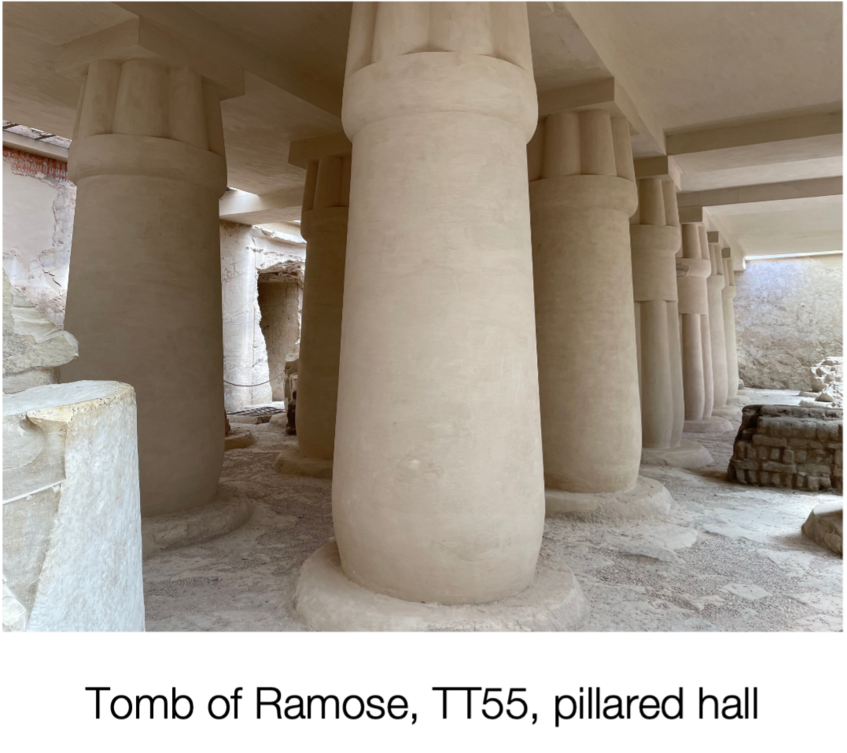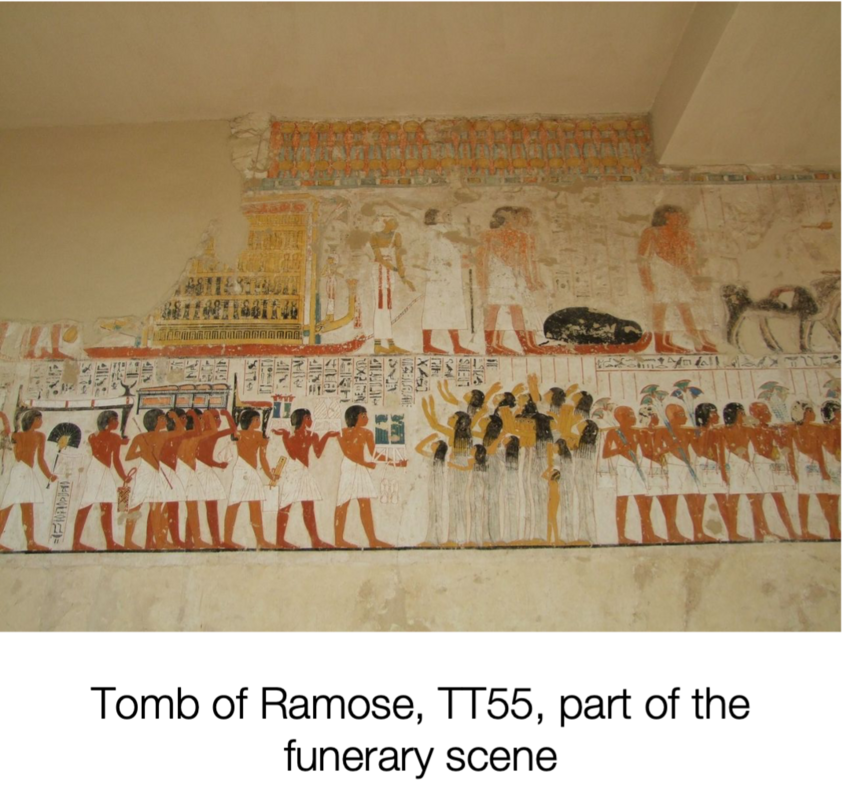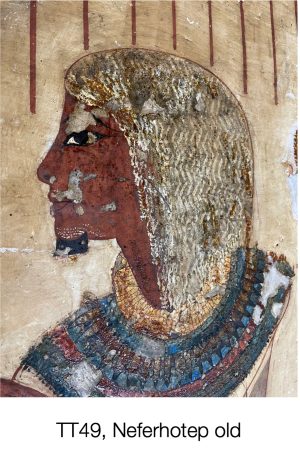Travel Report Luxor, April 19-26, 2024
by Lonneke Delpeut
My trip to Luxor lasted a week, which meant I had to divide my time carefully. The purpose of this trip was mainly to take photographs of the tombs that I study in my dissertation, which are 18th dynasty private tombs in the Theban Necropolis (circa 1549-1292 BC). The Necropolis is divided into five sub-parts, namely Sheikh abd el Qurna, el Khokha, Dra Abu el Naga, Qurnet Murai and Assasif. All five of these parts were used during the 18th dynasty, however no tombs built during that time period were open at this time in Assasif, so I focused on the other parts, mainly Sheikh Abd el Qurna. The Egyptian elite liked to build their tombs there, consisting of a public part (the tomb chapel) and a non-public part (the burial chamber), because the tombs were made to be seen and this necropolis is closely located to busy areas, specifically the royal temples. The tomb chapel was decorated with paintings revolving around the tomb owner, which are the scope of my research project.


On the first day I set out early in the morning and visited Sheikh abd el Qurna the first time and took photos of TT55, the tomb of Ramose, TT56, the tomb of Userhat, and TT57, the tomb of Khaemhat. All three tombs are very different: Ramose’s tomb is really big, showing how important he was, whereas Userhat’s tomb is relatively small. Ramose’s tomb is a combination of relief and painting, whereas Userhat’s tomb shows no relief at all; a clear difference in access to resources. It was my first time in the tomb of Ramose, and it left quite an impression (see pictures above). On the second day, I went back to Sheikh Abd el Qurna to visit the other tomb group, namely TT100, the tomb of Rekhmire, TT343, the tomb of Benia, TT69, the tomb of Menna and TT52, the tomb of Nakht. The tomb of Rekmire is very impressive due to its size; Rekhmire was mayor of Thebes, and his tomb is very high, which means there was more wall surface to decorate. The tomb of Menna was also very impressive, and the Egyptian guard was kind enough to also allow us into the long hall, which is usually restricted to visitors. This part of the tomb has the tomb owner hunting in the marshes, one of the topics I treat in my dissertation, which is why I’m so happy that I was allowed to take photographs of this part too. All these tombs are 18th dynasty tombs that are part of the scope of my project so I was very happy to study them all in-person and take my own pictures.

The third day I spent on the East bank visiting the Luxor Museum, the Karnak temple and the Abu Hajaj mosque. This mosque is built on top of the Karnak temple, and still in use, meaning that this is the only part of the ancient Egyptian temple that is still used for what it was built: worshipping. The Luxor temple was magnificent too, and partly contemporary to the tombs I study, which is why it was interesting to compare the wall depictions to the tomb depictions. It is likely that some of the artists who worked on royal temples also worked for private patrons in the Theban necropolis. The Luxor museum contained some recent finds from the necropolis, which are from the part of the tomb that I do not study (the burial chamber) but it does put the tomb nicely into perspective.
The fourth day was an intense day, since the thermometer hit 30C at 8.00 and I visited two parts of the Necropolis, namely el Khokha and Dra Abu el Naga. In el Khokha I saw TT295, the tomb of Paroy, TT296, the tomb of Nefersekheru, TT178, the tomb of Kenro / Neferrenpet and TT49, the tomb of Neferhotep. This last tomb has only been open for a few months after years of careful excavation and restoration and was without a doubt one of my highlights of this trip. Before this trip I did not have enough visual material available to use it in my dissertation, but now I do. A highlight were depictions of the tomb owner where he depicts himself with grey hair, including his beard, conveying old age (see picture). This is highly unusual in Egyptian private tombs, since the tomb owners usually show themselves as timeless as possible. In Dra Abu el Naga another seven tombs were open, of which the recently opened TT11, the tomb of Djehuty was the absolute highlight. This tomb contained a very interesting hunting scene in relief which I can now use in my dissertation.
On the fifth day I visited Qurnet Murai, the last part of the Necropolis still to visit. This was the hottest day of the trip and unfortunately I had caught the curse of the Nile, so there were two very good reasons to take it a little easier. I saw TT40, the tomb of Huy, which is a late 18th dynasty tomb, contemporary of the one of Neferhotep mentioned above, and two 19th dynasty tombs. In this period the tomb decorations focus mainly on religious scenes, and unlike in the 18th dynasty tombs, there are hardly any secular scenes left. These scenes are a large part of what make these tombs interesting to me, as they tell us the most about the tomb owner’s life. Despite this, it was still great to compare these two tombs to other I had seen, and took photos nonetheless. This was the last part of the Theban Necropolis to visit, so on the sixth day I had some time to visit the temple of Hatshepsut in Deir el Bahri, and the temple of Ramses III in Medinat Habu. Both temples are on different sides next to the necropolis. As mentioned before, some artists are suspected to have worked both in the royal tombs and in the private necropolis, so comparing the scenes in the temple of Queen Hathshepsut was great. One can even find a depiction of the owner of TT11, Djehuty, in the temple of Hatshepsut. Since he was overseer of the works and very likely oversaw the building and decoration of this temple, he took the freedom to depict himself in a royal temple, something that was unheard of. He very likely also borrowed some workman and artists to build his own tomb, something that the tomb owner of TT100, Rekhmire, also did. It became very clear to me that having power in ancient Egypt is related to having a tomb in this necropolis.
Most work was done in the mornings, since the trip took place in the last week of Egypt and in the hottest week of the year so far. It was too warm to venture outside into a rocky sun-filled landscape after 12, so most of the work took place between 7.00 and 11.00. The hotel I stayed at, Hotel Marsam, is usually used by colleagues during their excavation seasons since it is located to close to the Necropolis, which enabled me to walk there every morning. It was really nice taking pictures of the tombs that I’m studying, especially since I’ll be able to use them in the publication of my dissertation, when the time comes. The best part for me however was being there, and seeing what the original tomb owners and their family would have seen. You cannot compare studying these tombs from their publications to actually being on-site, experiencing them like they did. You see different things than from photographs and line drawings alone. On a personal note, I have been publishing on horses in ancient Egypt for years now, in relation to my BA an MA thesis, and am very happy that I finally have my own pictures of horses in tombs that I can use now. I am very grateful to the Österreichische Forschungsgemeinschaft, to the Doctoral School for Historical and Cultural Studies, to Studiecentrum Mehen and Huis van Horus for their financial support for this trip.
- Lonneke Delpeut is a university assistant (predoc) at the Department of Egyptology and a histcult:doc fellow. Read more about Lonneke and her project here.
